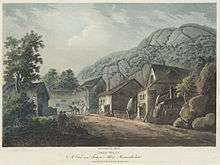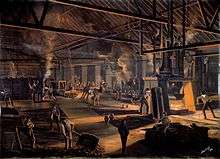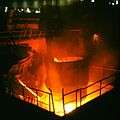Ironworks

.jpg)
An ironworks or iron works is a building or site where iron is smelted and where heavy iron and steel products are made. The term is both singular and plural, i.e. the singular of ironworks is ironworks.
Ironworks succeed bloomeries when blast furnaces replaced former methods. An integrated ironworks in the 19th century usually included one or more blast furnaces and a number of puddling furnaces or a foundry with or without other kinds of ironworks. After the invention of the Bessemer process, converters became widespread, and the appellation steelworks replaced ironworks.
The processes carried at ironworks are usually described as ferrous metallurgy, but the term siderurgy is also occasionally used. This is derived from the Greek words sideros - iron and ergon or ergos - work. This is an unusual term in English, and it is best regarded as an anglicisation of a term used in French, Spanish, and other Romance languages.
Varieties of ironworks
Primary ironmaking



Ironworks is used as an omnibus term covering works undertaking one or more iron-producing processes.[1] Such processes or species of ironworks where they were undertaken include the following:
- Blast furnaces — which made pig iron (or sometimes finished cast iron goods) from iron ore;
- Bloomeries — where bar iron was produced from iron ore by direct reduction;
- Electrolytic smelting — Employs a chromium/iron anode that can survive a 2,850 °F (1,570 °C) to produce decarbonized iron and 2/3 of a ton of industrial-quality oxygen per ton of iron. A thin film of metal oxide forms on the anode in the intense heat. The oxide forms a protective layer that prevents excess consumption of the base metal.[2]
- Finery forges — which fined pig iron to produce bar iron, using charcoal as fuel in a finery (hearth) and coal or charcoal in a chafery (hearth);
- Foundries — where pig iron was remelted in an air furnace or in a foundry cupola to produce cast iron goods;
- Potting and stamping forges with melting fineries using the first process in which bar iron was made from pig iron with mineral coal or coke, without the use of charcoal;
- Puddling furnaces — a later process for the same purpose, again with coke as fuel. It was usually necessary for there to be a preliminary refining process in a coke refinery (also called running out furnace). After puddling, the puddled ball needed shingling (metallurgy) and then to be drawn out into bar iron in a rolling mills.
Modern steelmaking
From the 1850s, pig iron might be partly decarburised to produce mild steel using one of the following:[3]
- The Bessemer process in a Bessemer converter, improved by the Gilchrist-Thomas process;
- The Siemens-Martin process in an Open hearth furnace;
- Electric arc furnace, introduced in 1907;
- Basic oxygen steelmaking, introduced in 1952.
The mills operating converters of any type are better called steelworks, ironworks referring to former processes, like puddling.
Further processing
After bar iron had been produced in a finery forge or in the forge train of a rolling mill, it might undergo further processes in one of the following:
- A slitting mill - which cut a flat bar into rod iron suitable for making into nails.
- A tinplate works - where rolling mills made sheets of iron (later of steel), which were coated with tin.
- A plating forge with a tilt hammer, a lighter hammer with a rapid stroke rate, enabling the production of thinner iron, suitable for the manufacture of knives, other cutlery, and so on.
- A cementation furnace might be used to convert the bar iron (if it was pure enough) into blister steel by the cementation process, either as an end in itself or as the raw material for crucible steel.
Manufacture
Most of these processes did not produce finished goods. Further processes were often manual, including
- Manufacturing by blacksmiths or more specialist kind of smith.
- It might be used in shipbuilding.
In the context of the iron industry, the term manufacture is best reserved for this final stage.
Notable ironworks

Great Britain
- (see also List of ironworks in Wales)
- Blaenavon Ironworks Heritage Site. Blaenavon (Blaenafon) South Wales
- Coalbrookdale Ironworks
- Cyfarthfa Ironworks at Merthyr Tydfil, Glamorgan, south Wales
- Dowlais Ironworks also at Merthyr Tydfil
- Millwall Ironworks, a shipbuilding firm on the Isle of Dogs, on the River Thames, London, England
- Thames Ironworks and Shipbuilding Co. Ltd, a shipbuilding firm at Leamouth on the River Thames, England
- Vulcan Iron Works at Bradford and other places
United States of America
- Bath Iron Works in Maine
- Burden Iron Works in Troy, New York
- Cambria Iron Company in Johnstown, Pennsylvania
- Falling Creek Ironworks, Virginia.
- Saugus Iron Works in Saugus, Massachusetts
- Toledo Iron Works in Miami, Florida
- Tredegar Iron Works at Richmond, Virginia
- Vulcan Iron Works in Pennsylvania and other places
Czech Republic
Germany
- Völklingen Ironworks Heritage Site
Spain
Historical
- Kindiba, in Burkina Faso. Ancient iron extraction site consisting of mines and three clay built furnaces.
- Darkhill Ironworks, in the Forest of Dean, England. Experimental ironworks established in 1818 and designated an 'Industrial Archaeological Site of International Importance'
- Royal Ironworks of St John, Ipanema, in São Paulo state, Brazil
References
- ↑ Hayman, Richard (2005). Ironmaking: History and Archaeology of the British Iron Industry. History Press.
- ↑ 9 May 2013 (2013-05-09). "A new iron age?". The Why Files. Retrieved 2014-02-06.
- ↑ Ghosh, Ahindra; Chatterjee, Amit (2008). Ironmaking and Steelmaking: Theory and Practice. Prentice-Hall of India.
External links
![]() Media related to Ironworks at Wikimedia Commons
Media related to Ironworks at Wikimedia Commons
